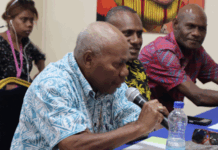
SPECIAL REPORT: Shirley Mauludu in Port Moresby reports on the earthquake which hit parts of three Highlands provinces almost two weeks ago, leaving behind a trail of destruction, injuries, loss of lives and massive damage to infrastructure. This is how economist and Institute of National Affairs executive director Paul Barker described the challenges of recovery to her.
At this stage, the outcome is still uncertain after the devastation and loss of life – now more than 100 – of Papua New Guinea’s Highlands earthquake.
Obviously the biggest concern remains the human impact of the earthquake – reaching the victims and providing emergency relief.
Many households and communities have no drinking water and food gardens have been destroyed.

There must be thorough mapping of the affected areas to ensure that no affected communities remain isolated or without support or relief where in need.
Also, all the landslides need to be checked, not only where they block roads, or have destroyed food gardens or houses, but also where they’ve blocked streams and rivers.
This could result in future floods or surge damage downstream when the dam is breached in future.
Economically, the earthquake has damaged food crops and cash crops, and local trade – the disruption to access roads, highways and bridges, and damage to stores and other businesses and infrastructure, including telecommunications towers, power plants and power lines.
Costing tens of millions of kina
Repairs will costs tens of millions of kina, with the government unfortunately only budgeting each year a fraction of what’s needed for infrastructure maintenance, let alone for emergency repairs and restoration.
From past experience, such as after Cyclone Guba in 2007, repairs of core bridges and infrastructure can take many years, although the presence of major resource companies, partially needing some of that infrastructure, and with their organisational and plant capacity, it can be expected that at least some of that infrastructure will be restored more promptly.
Although most of the businesses and households would have been uninsured against earthquake damage, the restoration process will generate some valuable local economic activity for the disaster-affected communities, in terms of jobs and business activity in the building and construction industry.
In terms of the larger economic impact, the major 7.5/6 earthquake of February 26 and the series of ensuing aftershocks and associated quakes, have halted or impacted several of the country’s largest businesses, notably in the extractive industries.
For example, Kutubu oil production (and associated fields), PNG LNG gas production, Ok Tedi Mine in Western and Porgera mine – notably its power generation and reticulation from Hides.
It is too early to say how major the impact is or how long the delay will be to production and exports from each of these major resource projects.
The respective operating companies are still in the process of their assessments of the core resources, wells and accessible reserves, surface and underground mine sites etc, processing/conditioning plants, power plants, pipelines, as well as transport and communications.
Epicentre near the Hela border
Clearly, the greatest damage was experienced nearest the epicentre to the main quake – near the Hela/Western Province border, including the major Komo airfield.
Extensive damage to staff quarters and other company facilities was sustained.
But that can be restored fairly promptly, compared with damage to costly and fundamental plant that may have been sustained.
One would expect some projects to be able to resume production and exports relatively soon, and some may have barely interrupted operations, for example with Porgera using a partial back-up power supply.
Although damage has been sustained by Ok Tedi and Porgera, they are likely to be able to resume full operations more readily after repairs.
The oil, but particularly LNG and condensate plants, and wells etc, may well require more extensive and costly repairs, potentially keeping some of these operations out of production for significantly longer.
ExxonMobil has declared force-majeure, enabling them to avoid their contractual supply contracts as a result of forces beyond their control.
Exports will halt
A few LNG initial shipments can presumably proceed from LNG stored in tanks in the facility near Port Moresby. But beyond a week or so, production and exports would presumably halt.
Papua New Guinea had about K25 billion worth of overall exports in 2016, of which around K20 billion was from minerals, oil and gas.
If K11 billion was oil and gas, and production was halted for say two months, that would comprise a loss of near K2 billion of exports.
If a major portion of mineral production was halted by one month, that could be up to another K0.5 billion of exports lost, or rather deferred.
Oil, gas and most mineral prices are largely significantly above the levels in 2016. So in 2018, the loss of exports earnings would be higher than the figures stated here.
The LNG is not currently contributing to foreign exchange receipts but the mineral and oil exports largely are. So it would significantly reduce needed forex receipts.
Although company tax revenue was well below K100 million from the mining/oil/gas sector in 2017, it was expected that this figure would have been up (to K89.5 million, still a very low figure, considering the level of exports), particularly coming from Ok Tedi and Porgera.
Cut back in tax receipts
These tax receipts would be cut back if production was significantly halted, and the companies have to reinvest heavily in major repairs and new plant.
Dividends have been received, however, from the state’s equity in PNG LNG, and oil and mining operations, which would also take a cut, if production was heavily reduced, and major expenditure incurred, which seems inevitable at this stage, all adding to
the already very tight fiscal situation the government faces this year.
With major expenditure required by the government as its contribution to restoration of infrastructure and services in the affected areas (K450 million has been committed, although it is not known the basis of this number of the source of the allocation) then that clearly adds further to the fiscal pressure.
Shirley Mauludu is a journalist with The National daily newspaper. The article has been republished under Creative Commons.












































